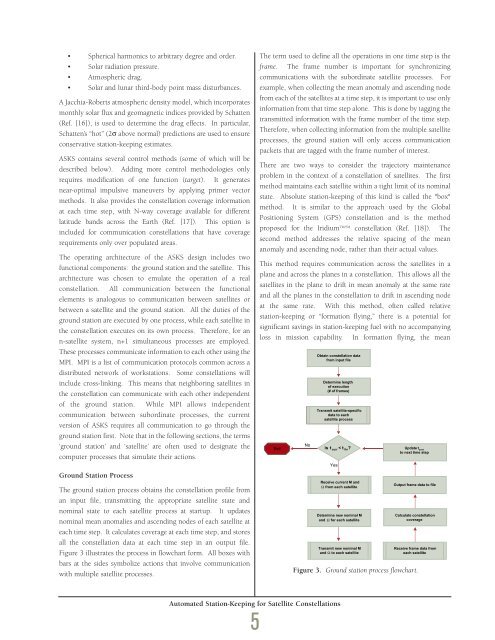1998 - Draper Laboratory
1998 - Draper Laboratory
1998 - Draper Laboratory
- No tags were found...
Create successful ePaper yourself
Turn your PDF publications into a flip-book with our unique Google optimized e-Paper software.
• Spherical harmonics to arbitrary degree and order.• Solar radiation pressure.• Atmospheric drag.• Solar and lunar third-body point mass disturbances.A Jacchia-Roberts atmospheric density model, which incorporatesmonthly solar flux and geomagnetic indices provided by Schatten(Ref. [16]), is used to determine the drag effects. In particular,Schatten’s “hot” (2σ above normal) predictions are used to ensureconservative station-keeping estimates.ASKS contains several control methods (some of which will bedescribed below). Adding more control methodologies onlyrequires modification of one function (target). It generatesnear-optimal impulsive maneuvers by applying primer vectormethods. It also provides the constellation coverage informationat each time step, with N-way coverage available for differentlatitude bands across the Earth (Ref. [17]). This option isincluded for communication constellations that have coveragerequirements only over populated areas.The operating architecture of the ASKS design includes twofunctional components: the ground station and the satellite. Thisarchitecture was chosen to emulate the operation of a realconstellation. All communication between the functionalelements is analogous to communication between satellites orbetween a satellite and the ground station. All the duties of theground station are executed by one process, while each satellite inthe constellation executes on its own process. Therefore, for ann-satellite system, n+1 simultaneous processes are employed.These processes communicate information to each other using theMPI. MPI is a list of communication protocols common across adistributed network of workstations. Some constellations willinclude cross-linking. This means that neighboring satellites inthe constellation can communicate with each other independentof the ground station. While MPI allows independentcommunication between subordinate processes, the currentversion of ASKS requires all communication to go through theground station first. Note that in the following sections, the terms‘ground station’ and ‘satellite’ are often used to designate thecomputer processes that simulate their actions.Ground Station ProcessThe ground station process obtains the constellation profile froman input file, transmitting the appropriate satellite state andnominal state to each satellite process at startup. It updatesnominal mean anomalies and ascending nodes of each satellite ateach time step. It calculates coverage at each time step, and storesall the constellation data at each time step in an output file.Figure 3 illustrates the process in flowchart form. All boxes withbars at the sides symbolize actions that involve communicationwith multiple satellite processes.The term used to define all the operations in one time step is theframe. The frame number is important for synchronizingcommunications with the subordinate satellite processes. Forexample, when collecting the mean anomaly and ascending nodefrom each of the satellites at a time step, it is important to use onlyinformation from that time step alone. This is done by tagging thetransmitted information with the frame number of the time step.Therefore, when collecting information from the multiple satelliteprocesses, the ground station will only access communicationpackets that are tagged with the frame number of interest.There are two ways to consider the trajectory maintenanceproblem in the context of a constellation of satellites. The firstmethod maintains each satellite within a tight limit of its nominalstate. Absolute station-keeping of this kind is called the "box"method. It is similar to the approach used by the GlobalPositioning System (GPS) constellation and is the methodproposed for the Iridium TM/SM constellation (Ref. [18]). Thesecond method addresses the relative spacing of the meananomaly and ascending node, rather than their actual values.This method requires communication across the satellites in aplane and across the planes in a constellation. This allows all thesatellites in the plane to drift in mean anomaly at the same rateand all the planes in the constellation to drift in ascending nodeat the same rate. With this method, often called relativestation-keeping or “formation flying,” there is a potential forsignificant savings in station-keeping fuel with no accompanyingloss in mission capability. In formation flying, the meanEndNoObtain constellation datafrom input fileDetermine lengthof execution(# of frames)Transmit satellite-specificdata to eachsatellite processis t curr < t fin ?YesReceive current M andΩ from each satelliteDetermine new nominal Mand Ω for each satelliteTransmit new nominal Mand Ω to each satelliteUpdate t currto next time stepOutput frame data to fileCalculate constellationcoverageReceive frame data fromeach satelliteFigure 3. Ground station process flowchart.Automated Station-Keeping for Satellite Constellations5
















